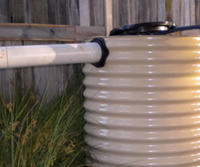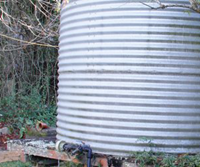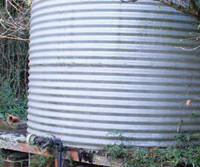Installing a rainwater tank
Installation advice and tips
There are a number of points to consider when installing your rainwater tank.
When should I install my tank?
The best time to install a rainwater tank is when you don’t need it. Fitting your tank at the beginning of your wet season will ensure that you have as much water as possible to sustain you during the dry season.
How should I maintain my tank?
Remember that ‘prevention is better than the cure’, so keep your gutters free from debris with a range of devices or just by cleaning them out regularly. The tank itself needs regular external inspections for leaks and an internal inspection for sludge every few years. This can be dangerous so contact a professional if you need help doing this.
What about plumbing and preparation?
There are a number of steps involved in installing a rainwater tank. Ask your plumber to give you a comprehensive quote on installation that fully complies with local and national legislation.
Plumbing
A plumber will be able to give you some great advice about water tanks, such as the best location and size. You will also be able to get an idea of how much the entire project will cost. A licensed plumber is required by law wherever a tank is connected to the mains water supply, such as a tank to toilet system. A plumber is also required to connect your gutters to your tank and install an overflow to the stormwater system. It is important to ensure that your tank's overflow is securely connected to the stormwater system. A number of tank manufacturers can organise a plumber to provide installation for you. Some tank installations (particularly for large tanks) may require a building permit. Check with your local council.
Delivery
In most situations, you can arrange delivery with the manufacturer or retailer. It is important to ensure that there is clear access from the street to where you want to put your tank.
Foundations
The ground where a tank is going to be located needs to be levelled. Larger tanks will also require either sand or concrete foundations. The tank manufacturer’s instructions will guide you, but a plumber should also be consulted when deciding where to put your tank to maximise the catchment area.
Gutters and roofing
The guttering on your roof catches the water for your tank and needs to be regularly cleared of any leaves or debris. Damaged guttering should also be repaired.
What accessories will I need?
There are a variety of rainwater tank accessories to help you collect and store water. This list will help you decide which items you need.
Pumps
Most rainwater tank systems will require a pump to generate adequate pressure. Washing machines and some irrigation systems require a level of pressure similar to mains water. When connecting your rainwater supply to your toilet or laundry, leading plumbers recommend a pump which will automatically switch to mains supply when your tank water runs dry. In times of water restrictions you must ensure you are not using mains supply on your garden. You also need to provide electricity to the pump close to the tank. Be mindful of neighbours as pumps can be quite loud. Consider choosing a pump with nylon blades as they are quieter than ones with metal blades.
First flush diverters
These devices are useful to divert the first 20 litres of rainfall from entering your tank. This will prevent pollutants on your roof from entering the tank. For example, many roofs have lead flashing which can be dangerous. A sump box between the downpipe and the tank can slow the water flow down, separating out any sediment not previously diverted.
Backflow prevention valves
Regulations stipulate that backflow devices must be installed to prevent tank water from entering the mains system. Most households have backflow prevention devices installed at the water meter. Some pumps also act as a backflow prevention so extra valves are not required. Ask your plumber for further advice.
Connections, pipes and fittings
Make sure you ask your plumber about the additional extras you need as they can increase the total cost. Your quote should also include all measures to meet government standards.
Mosquito proofing
A rainwater tank can be an attractive refuge for insects and other creatures. They are especially enticing as a breeding ground for mosquitoes. There are a range of products you can install on your downpipes and overflows to prevent insects from getting into your water, including mosquito proof mesh.
Leaf-shedding gutter protection
Leaves and debris often build up in gutters. This can affect water flow during heavy downpours and can potentially contaminate your water supply. Avoid U-shaped gutters as they trap leaves and twigs. Gutter protectors, filters and regular maintenance can help to solve this problem.
Tank stands
A tank stand can provide additional pressure (if you choose not to install a pump) and can make it easier to fill watering cans and buckets at the tank. The type of tank stand or foundation you require will depend on the material, size and weight of your tank. Ensure that you ask your tank manufacturer before you purchase the tank, as the stand may be included. Some stands require building permits so you should consult your local council.
Trickle top-up systems
Trickle top-up systems use a float valve to measure how much water you have in your tank. When the water level gets too low, mains water will trickle into the tank to top it up. If the tank contains mains water you cannot use it on the garden during water restrictions.
Safety
Ensure taps that are using rainwater are clearly labelled.
Discover more about using rainwater tanks:
Choosing a rainwater tank | Maintaining a rainwater tank | Rainwater tanks |



